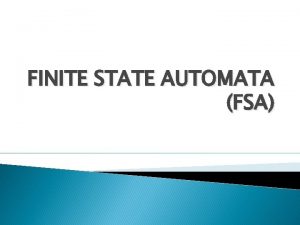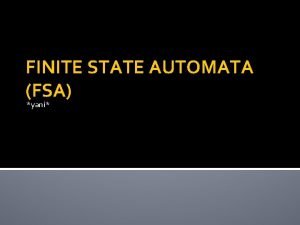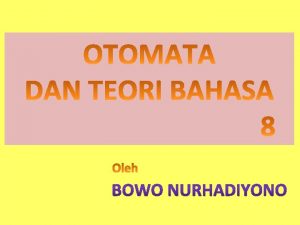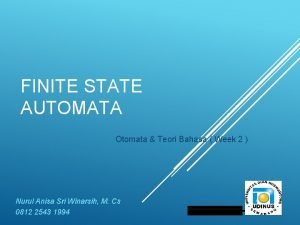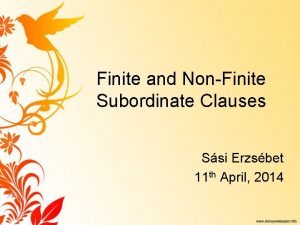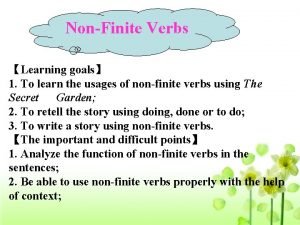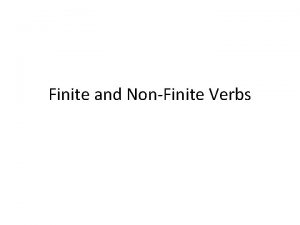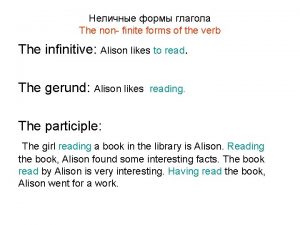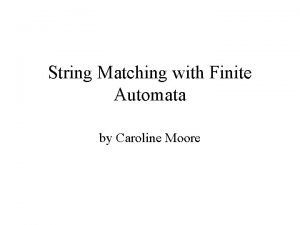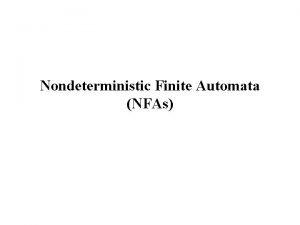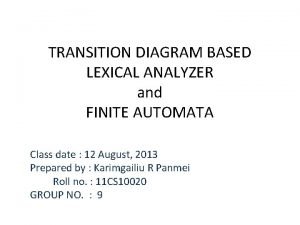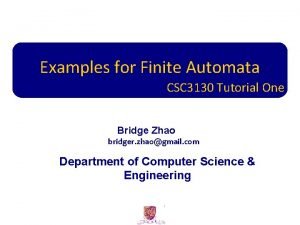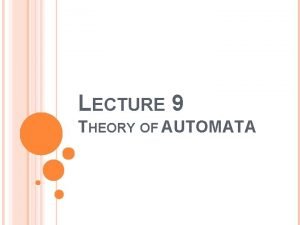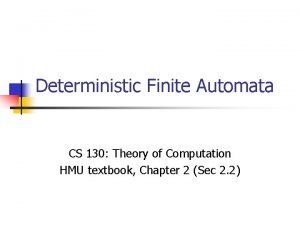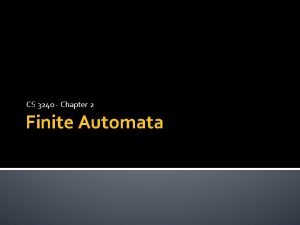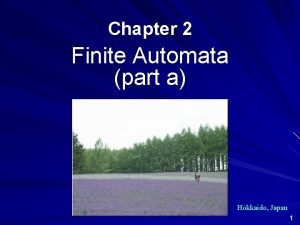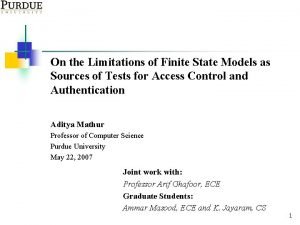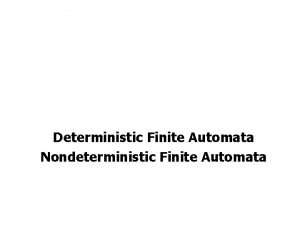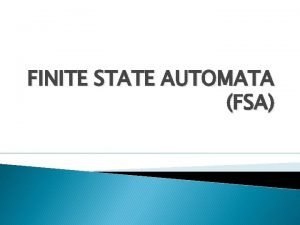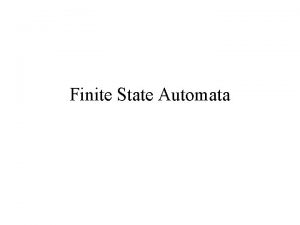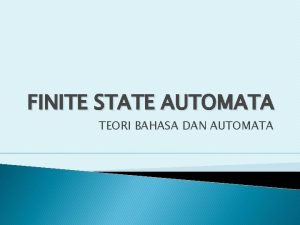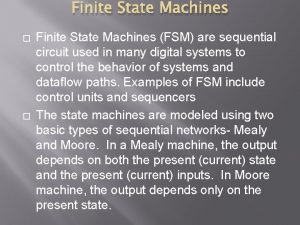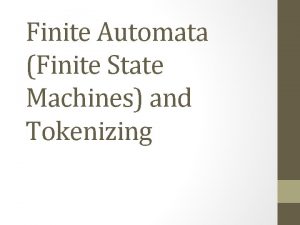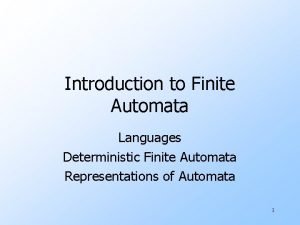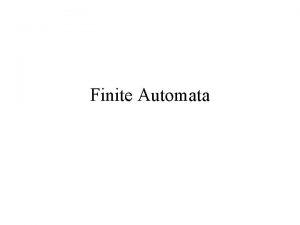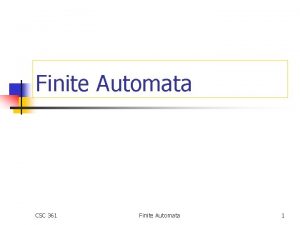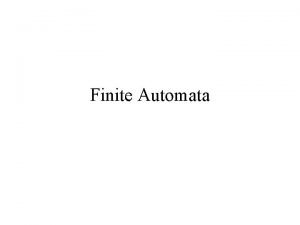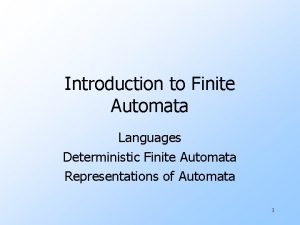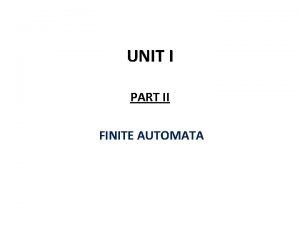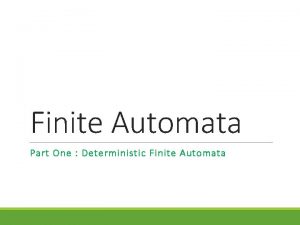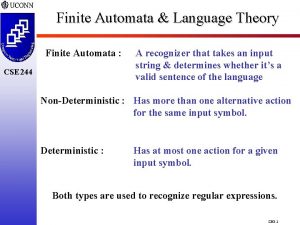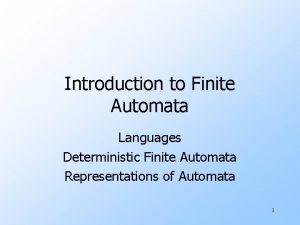Modeling with Automata Componentdriven modeling Finite State Machines





















- Slides: 21

Modeling with Automata Component-driven modeling. Finite State Machines. Petri Nets.

Review System dynamics Paradigms System Dynamics : A sequence of State transitions Model : A set of rules for a State transition CVDS Differential Equations (physical system) System S DTDS Difference Equations (sampled system) DEDS Timed Automata, DEVS X DDS Digital System (Digital Voice, FSM) Y

System dynamics Paradigms System Dynamics : A sequence of State transitions Model : A set of rules for a State transition X System S Y

Dynamic Systems representations System Specifications: DESS: differential equation Simulator: Numerical Integrator System DESS model: dq/dt = a*q +bx DTSS: difference equation DEVS: discrete event Simulator: Recursive Algorithm Simulator: Events Processor System DEVS model DTSS model: q(t+1) = a*q(t)+ b*x(t) time to next event, state at next event. . .

Systems theoretical modelling Behavioral models: ‘Black boxes’. – Define input/output behavior. – Representation of observable and non-observable variables. Structural models: ‘White boxes’. – Represent system internal structure. – Decomposition and coupling. – Refers to elements in a model as opposed to the behavior it generates. Different formalisms derived from these ideas.

Component definition Component: viewed as a model with inputs and outputs. It has internal structure which dictates how inputs/states are transformed to outputs. INTERNAL STRUCTURE inputs states functions outputs Components are coupled together to create models, which themselves can be components in larger models.

Component-based system dynamics To capture system’s dynamics, we need to represent states and how they change over time, autonomously and/or in response to external events: – – – Inputs States Outputs Time it takes for an activity to be completed Internal Dynamics

Finite State Machines FSM = < S, X, Y, , > – – X : input set Y : output set S : state set , : functions with the following constraints • • X, Y, S : finite sets : X*S S : S Y : Moore machine : X * S Y : Mealy machine S x Untimed discrete event system Timed versions of FSMs associate time with states or transitions. y

Finite State Machines FSM = < S, X, Y, , > – – X : input set Y : output set S : state set , : functions with the following constraints S • X, Y, S : finite sets • : X*S S x y

Finite State Machines FSM = < S, X, Y, , > – – X : input set Y : output set S : state set , : functions with the following constraints • X, Y, S : finite sets • : X*S S • : S Y : Moore machines: non-reactive (response delayed by 1 cycle) easy to compose Always well-defined. S x y

Finite State Machines FSM = < S, X, Y, , > – – X : input set Y : output set S : state set , : functions with the following constraints • • X, Y, S : finite sets : X*S S : S Y : Moore machine : X * S Y : Mealy machine S x y Moore machines: Mealy machines: (response delayed by 1 cycle) (0 response time) Always well-defined. Problems with combinational cycles. non-reactive easy to compose reactive hard to compose

Example: FSM modeling Banking system: Queue+Server in (1) Conceptual Model components descriptive variables (state variables) dependency: interaction between components (i) Descriptive variables Queue – Queue length: [0. . . N] – “queue. length = n”: n customers in the waiting line – Server’s status: [Busy, Free] (ii) Interaction with outside world – When a customer arrives: • System puts it in the queue • Serve customer (in some specified time) • Send customer out Server out

FSM formal definition (2) Formal model specification: M = <X, Y, S, , > From informal description, the following should be specified – (i) Identify X, Y, S – (ii) State transition function – (iii) Output function (3) Case I : – – – – state : Queue Length in 0 in 1 in 2 … out M = <X, Y, S, , > X = {in} Queue Y = {out} in S = {queue. length in [0, N]} : X * S S (in, n) = n+1 for all n<N (Obs: there is no out in transition function) : S Y (n 0) = out Problem : queue. length never decreases solution : introduce a feedback to notify that a customer is leaving in N out

Modified formal definition: queue <Modified> M = <X, Y, S, , > – – – X = {in, done} Y = {out} done = out S = {queue. length in [0, N]} : X * S S – – (in, n) = n+1 for all 0 n <N (done, n) = n-1 for all 0 < n N : S Y (n 0) = out in Queue out done Feedback in in 0 done 1 out in … done 2 done in done N out ‘done’ is introduced by feedback out

Formal definition: server (3) Case II : state : Server Status – – – M = <X, Y, S, , > X = {in, done} Y = {out} done = out S = server. status in [B, F] : X * S S – (in, B) = B – (in, F) = B – (done, B) = B if queue. length > 1 F if queue. length <= 1 – (done, F) = N/A – : S Y – (S=B) = out server in done (|q|>1) done (|q| 1) B F out in in done in in Server done out Feedback out

CFSM State Set: queue + server < Case I + Case II > : X * S S S = {(queue. length, server. status) | queue. length is in [0. . . N] and server. status [B, F]} Server. status out F out out out done in in in B in done 0 1 2 3 in in done N-3 N-2 N-1 N : undefined state queue. length

Formal definition of CFSM Formal specification of CFSM – CFSM = < E , Q , q 0 , T , {FSM} > • • • E : Events set Q : States set q 0 : Initial state T : Transition relations FSM : ith FSM With the following constraints:

Example: Synchronous Machine of ping-pong players player_A = <XA, YA, SA, A > player_B = <XB, YB, SB, B> XA = {Ball_B} YA = {Ball_A} SA = {A_A, A_D} A , A : exercise player_A Ball_B A_D A_A Ball_A /Ball_A player_B Ball_A XB = {Ball_A} YB = {Ball_B} SB = {B_A, B_D} B, B : exercise Ball_A B_D B_A /Ball_B

CFSM for the ping-pong example player_A player_B Ball_B D A Ball_A Ball_B Ball_A D /Ball_A A /Ball_B Ball_A CFSM A_A, B_D A_D, B_A Ball_B /Ball_A A_D Problem : player_A output: Ball_A. Transition ?

CFSM for the ping-pong example player_A player_B Ball_B D A Ball_A Ball_B Ball_A D /Ball_A A /Ball_B Ball_A CFSM A_A, B_D A_D, B_A Ball_B Player_A : X S S XA = {Ball_B} { } : internal event Ball_A A_A A_D A_A Ball_B A_A A_D Ball_A /Ball_B feedback A_D

CFSM for the ping-pong example (cont) CFSM = <E, Q, q 0, T, {player_A, player_B}> – E = Xi Yi Xj Yj = {Ball_A, Ball_B} – q 0 = (A_A, B_D) – Q SA SB ({(A_A, B_D), (A_D, B_A)} = Q} Ball_A A_A, B_D A_D, B_A Ball_B
 Soal dan jawaban uts teori bahasa dan automata
Soal dan jawaban uts teori bahasa dan automata Contoh fsa
Contoh fsa Diagram fsa
Diagram fsa Mesin mealy
Mesin mealy Aturan tata bahasa reguler
Aturan tata bahasa reguler Deterministic finite state automata
Deterministic finite state automata Gambarlah diagram transisi untuk nfa berikut
Gambarlah diagram transisi untuk nfa berikut Finite and non finite subordinate clauses
Finite and non finite subordinate clauses Finite verb
Finite verb Learning objectives of non finite verbs
Learning objectives of non finite verbs How to find finite and nonfinite verbs
How to find finite and nonfinite verbs Finite and non finite
Finite and non finite String matching with finite automata
String matching with finite automata Automata
Automata Lexical analysis finite automata
Lexical analysis finite automata Finite state diagram generator
Finite state diagram generator Csc3130
Csc3130 Kleene's theorem part 2
Kleene's theorem part 2 Automata calculator
Automata calculator Finite automata
Finite automata Informal picture of finite automata
Informal picture of finite automata Limitations of finite state machine
Limitations of finite state machine

